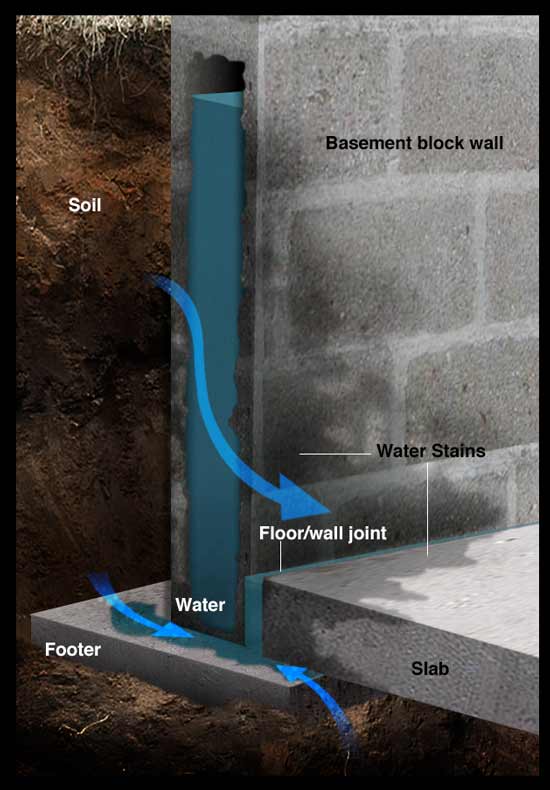Have you ever woken up to find your basement floor damp, or worse, a puddle of water pooling in the corner? It’s a homeowner’s nightmare. Water seeping into your basement can cause major damage, from mold growth to structural issues. But fear not! You don’t have to live with a leaky basement. This comprehensive guide will walk you through the common causes of water infiltration, provide practical solutions, and empower you to reclaim your basement space.
Image: phenergandm.com
Understanding the source of the problem is crucial for choosing the right solution. The culprits behind those unwelcome basement drips can range from a simple clogged downspout to more complex issues like cracks in the foundation. By diagnosing the problem accurately, we can effectively prevent future water damage and keep your basement dry, safe, and usable.
Identifying the Source: Tracing the Water Trail
1. The Gutters and Downspouts: A Common Culprit
Overflowing gutters and blocked downspouts are notorious for contributing to basement leaks. When rainwater can’t drain properly, it has nowhere to go but down, often finding its way into cracks in your foundation or through poorly sealed windows and doors.
Solution: Regularly clean your gutters, ensuring they are free of debris. Make sure downspouts are directed away from your foundation and properly extend at least 5 feet from the house. Consider installing gutter guards to minimize future blockages.
2. The Foundation: Cracks and Gaps Are Vulnerable Points
Cracks in your foundation are a major pathway for water to enter your basement. These cracks can occur due to shifting soil, settling ground, or even tree roots pushing against the foundation. Even seemingly minor hairline cracks can allow water to seep through over time.
Solution: Inspect your foundation for cracks, paying close attention to areas around doors, windows, and corners. For small cracks, use a high-quality concrete sealant or epoxy. Larger cracks may require professional attention, possibly involving foundation repair.

Image: jjvs.org
3. The Windows and Doors: Sealing Off Weak Points
Windows and doors are natural entry points for moisture. Age, wear and tear, and even minor settling can create gaps around these openings, allowing water to infiltrate your basement.
Solution: Examine window and door frames for any gaps or cracks. Caulk these areas thoroughly to prevent water intrusion. If your windows are older and poorly insulated, consider replacing them with energy-efficient models.
4. The Plumbing System: Leaks Can Be Sneaky
Hidden plumbing leaks are another common cause of wet basements. Broken pipes, leaky faucets, dripping appliances, and even cracked sewer lines can all contribute to water damage. A small drip may seem insignificant, but over time, it can lead to serious problems.
Solution: Inspect your plumbing system regularly for leaks. Check for signs of dripping, damp spots, or rust stains. If you suspect a leak, call a licensed plumber to diagnose and repair the issue promptly.
Mitigating Moisture: Creating a Dry Basement
1. Dehumidification: Combatting Excess Humidity
High humidity levels in your basement can create a perfect breeding ground for mold and mildew. A dehumidifier helps remove moisture from the air, keeping your basement dry and preventing harmful growth.
Solution: Install a dehumidifier in your basement and set it to maintain a comfortable humidity level (around 30-50%). Remember to empty the dehumidifier’s water collection tank regularly to prevent overflow.
2. Ventilation: Air Circulation for a Dry Environment
Adequate ventilation helps control moisture levels and prevent condensation, which can lead to dampness and mold growth. Even a small amount of air circulation can make a big difference.
Solution: Install a basement ventilation fan to remove moisture and stale air. Make sure your basement windows have adequate ventilation and are opened regularly, especially after heavy rains.
3. Waterproofing: Creating a Moisture Barrier
For serious cases of water infiltration, waterproofing your basement is essential. This involves creating a barrier that prevents water from entering your basement, ensuring long-term dryness.
Solution: Professional waterproofing contractors can apply a waterproof membrane to the foundation walls and floor, typically using specialized materials such as liquid rubber or plastic sheeting. They may also install drainage systems around the foundation to collect and divert water away from your basement.
Taking Preventative Measures: Long-Term Protection
1. Landscaping: Directing Water Away from Your Home
Proper landscaping plays a critical role in preventing water from pooling near your foundation. Sloping your yard away from the house ensures rainwater runs off and doesn’t seep into your basement.
Solution: Grade your yard to ensure a slight slope away from the foundation. Plant trees and bushes at a distance from your home to avoid root damage to your foundation. Maintain your yard with proper drainage and irrigation.
2. Home Maintenance: Regular Inspection and Repair
Regular home maintenance is key to preventing costly repairs and ensuring long-term dryness. Inspecting your gutters, downspouts, windows, doors, and plumbing system regularly help you catch small issues before they become significant problems.
Solution: Establish a regular schedule for inspecting your basement, gutters, down spouts, and plumbing system. Address any repairs promptly to prevent further damage and ensure your basement stays dry and safe.
How To Fix Water Coming Through Basement Floor
Conclusion: A Dry and Usable Space
A wet basement can be a major headache, but with the right knowledge and preventative measures, you can reclaim your basement space and make it a functional and enjoyable part of your home. Identifying the source of water infiltration, implementing the appropriate solutions, and taking preventative measures will go a long way in keeping your basement dry, mold-free, and ready for whatever you choose to do with it.






